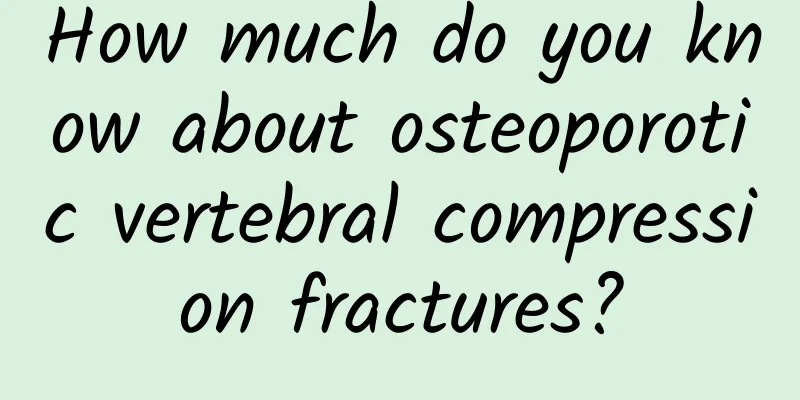How much do you know about osteoporotic vertebral compression fractures?

|
According to the results of the China Osteoporosis Epidemiological Survey released in 2018, the prevalence of osteoporosis in people over 50 years old in my country reached 19.2%, and the prevalence in people over 65 years old reached 32%. In 2015, 2.6 million osteoporotic fractures occurred in China, equivalent to one osteoporotic fracture every 12 seconds! Nearly half of them occurred in the vertebrae of the spine. The incidence of vertebral fractures is twice that of hip fractures; approximately 25% of postmenopausal women will suffer at least one vertebral fracture. Unlike hip fractures, vertebral fractures usually occur with little or no trauma. Osteoporosis prevents the vertebrae from bearing normal stresses, so they can break during simple movements—bending over, twisting the body quickly, or lifting light objects. Consequences of vertebral fractures A fractured vertebral body is characterized by collapse and compression, like a paper cup that is crushed when you step on it. The resulting pain may be sharp or dull, and may be located at the fracture site or in a distant area, such as the abdomen. In most cases, the pain is mild or absent, and the main symptom is a gradual loss of height or a kyphotic deformity. The extent of the loss of height and deformity depends on the number, location, and severity of the fractures. How to treat vertebral fractures X-rays of the spine can confirm the diagnosis. Vertebral compression fractures in postmenopausal women are usually caused by osteoporosis and occasionally by trauma, infection, or tumors. Nonsteroidal anti-inflammatory analgesics can be used to relieve the pain of vertebral fractures. Severe pain may require short-term bed rest and stronger drugs. However, long-term bed rest should be avoided because it may cause further bone loss and other problems, such as bedsores and blood clots in the veins. Wearing a thoracolumbar brace can also relieve pain and stabilize the spine while the fracture heals, taking pressure off the damaged vertebra and reducing the likelihood of further vertebral compression. The brace should not be worn for more than 3 months because it weakens the trunk muscles. Patients should be encouraged to do gentle exercise, such as swimming or walking, as long as they can tolerate it, and they should incorporate exercises that strengthen the trunk muscles into their daily routine. Patients should have bone density testing to diagnose osteoporosis, and osteoporosis should be treated with standard osteoporosis medications, such as bisphosphonates. Bisphosphonates can help relieve acute pain and improve bone density. Percutaneous vertebroplasty In 1990, French doctor Deramong applied percutaneous vertebroplasty to osteoporotic vertebral compression fractures and achieved satisfactory analgesic effects and vertebral strengthening effects - opening a new era in the treatment of such fractures. Vertebroplasty is a procedure in which a hollow tube is inserted into the compressed part of the vertebra through a small incision in the skin under the guidance of a fluoroscopic machine. An inflatable balloon is inserted through the tube, which expands to create a cavity and restore the height of the fractured vertebra. Then, the balloon is deflated and removed, and bone cement (methyl methoxyacetate) is injected, which is like toothpaste. The cement hardens in about 15 minutes, and the patient can resume walking upright. Recommended expert: Liu Zhaoxu Doctor of Medicine from Germany, Associate Professor, Associate Chief Physician, and Master's Supervisor in the Department of Orthopedics, Tongji Hospital Affiliated to Tongji Medical College, Huazhong University of Science and Technology. In 2009, he was sent by the state to study in Germany. In 2012, he obtained his doctorate with the honors of "summa cum laude" and continued his postdoctoral training at the Medical College of Hannover, Germany. In 2018, he was selected for the CAOS-NASS Traveling Fellowship international exchange program to study spinal surgery techniques in the Department of Spine Surgery at the University of Pittsburgh Medical Center in the United States. At present, he is mainly engaged in the diagnosis and treatment of spinal surgical diseases such as cervical spondylosis, lumbar disc herniation, lumbar spondylolisthesis, spinal fractures, spinal infections, and spinal tumors. He is currently a member of the North American Spine Surgery Association, a member of the AO SPINE Association, a young lecturer of AO SPINE, a member of the Intelligent Orthopedics Group of the Orthopedic Physicians Branch of the Chinese Medical Doctor Association, a member of the Science Popularization and Health Education Working Committee of the Chinese Medical Education Association, a member of the Spine Group of the Orthopedic Branch of the Hubei Medical Doctor Association, a member of the Spinal Cord and Spine Group of the Neurosurgery Professional Committee of the Hubei Neuroscience Society, a member of the Osteoporosis Professional Committee of the Hubei Gerontology Society, a young member of the Biological Treatment Professional Committee of the Neck, Shoulder, Waist and Leg Pain of the Hubei Biomedical Engineering Society, and a member of the Orthopedic Professional Committee of the Hubei Sports Human Science Research Association. He presided over two National Natural Science Foundation projects (one Youth Fund and one General Project), and published more than 20 SCI papers as the first author or corresponding author in journals such as Biomaterials, Stem Cell Research & Therapy, etc. In 2015, he translated and published "Spinal Surgery Technology" (co-translator). |
>>: What are the benefits of eating strawberry jam? How to eat strawberry jam
Recommend
What is the best time to swim every day? What should you pay attention to when swimming in cold weather?
Swimming is also a very physically demanding spor...
What to do if the weather is too hot during confinement
During the period of confinement, many traditions...
Exploring the mystery of cataracts: the mystery of the lens and changes in vision
1. Introduction Cataracts, a seemingly simple wor...
How many days after menstruation is it easy to get pregnant
In life, many couples use the safe period as a co...
How is vaginitis caused?
Vaginitis should never be ignored, because the ha...
What gynecological diseases require surgery?
Gynecological diseases, to put it simply, are a t...
What to do if breast milk engorgement occurs
Many people grow up drinking breast milk, and whe...
Premenstrual Disorder
Women who menstruate experience some mental, beha...
Can I have sex on the same day after a vaginal ultrasound?
B-ultrasound is a very important method of modern...
A woman dreams of cutting half of her hair
Many girls have long hair, but it is inconvenient...
What should not be eaten after induced abortion
Induced abortion is something that every female f...
How to cure Candida albicans
Candida albicans is not unfamiliar to women, beca...
14 week fetus picture
The 14th week of pregnancy belongs to the second ...
Is Wangbuliuxing breast enhancement method effective?
Every woman pays special attention to her "c...
The reason why menstrual period is a little dark
During women's menstrual period, if any physi...









